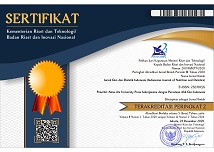Serum calcium as a candidate marker in detecting stunting in toddler
Abstract
Background: Monitoring the nutritional status of toddlers is a very important thing to do. Calcium is one of the blood parameters that can be assessed, because calcium deficiency will affect the child's linear growth. So far, monitoring of nutritional status is only based on anthropometry and is not followed by assessment of blood parameters. Objectives: This study aims to measure serum calcium levels as a candidate marker in detecting stunting in toddlers.
Method: The design of this research is cross sectional with 62 samples of toddlers aged 2-5 years. Data on sample characteristics was obtained through a questionnaire, as for serum calcium levels measurement, venous blood samples were taken and measured with the colorimetric method. The incidence of stunting is obtained based on TB/U measurements and Z-score was calculated using Anthro 1.02 software. Data were then analyzed univariately (frequency distribution) and bivariately (independent t-test and chi-square) using SPSS version 22.
Results: Based on anthropometric measurements, it was found that 21 (33.9%) toddlers had stunting, 28 (45.1%) toddlers had low Serum calcium levels and the majority of toddlers (54.9%) had normal serum calcium levels. There was no significant difference (p=0.989) in mean serum calcium levels between stunting and non-stunting toddlers (1.961 ± 0.223 µq/dL vs 1.960 ± 0.175 µq/dL). Bivariate results also showed that there was no significant relationship (p=0.414) between serum calcium levels and the incidence of stunting.
Conclusion: Measuring serum calcium levels cannot be used as a candidate marker for detecting stunting in toddlers. Further research is needed with a larger number of samples and measurements of various parameters related to calcium balance.
Keywords
Full Text:
PDFReferences
Grantham S, Cheung YB, Cueto S, Glewwe P, Richter L, Strupp B. Development potential in the first 5 years for children in developping countries. Lancet 2007;369:60-70.
Needlman RD. Growth and development. Dalam: Behrman dkk, penyunting. Nelson Textbook of Pediatrics; edisi-16. Tokyo: Saunders, 2000. h. 23-65.
Hagerman RJ. Growth & development. Dalam: Hay WW dkk, penyunting. Current pediatric diagnosis & treatment; edisi-12. Connecticut: Prentice-Hall, 1995. h. 65-84.
Berk LE. Child development; edisi-5. Singapore: Allyn and Bacon, 2000. h. 479-519.
WHO. (2010). Nutrition Landscape Information System (NLIS) country profile indicators: interpretation guide. Geneva, Switzerland: WHO Document Production Services.
Kementerian Kesehatan RI. (2019) Laporan Nasional Riskesdas 2018. http://labdata.litbang.kemkes.go.id/images/download/laporan/RKD/2018/Laporan_N asional_RKD2018_FINAL.
United Nation ChildrenFound (UNICEF).2012. Prevalensi balita stunting di Indonesia. Jakarta.
Kementerian Kesehatan Republik Indonesia (2018). Situasi Balita Pendek (Stunting) di Indonesia.
Prentice A, Bates CJ. An appraisal of the adequacy of dietary mineral intakes in developing countries for bone growth and development in children. Nutrition Research Reviews 1993;6(1):51-69.
Khairy SAM, Mattar MK, Refaat LAM, El-Sherbeny SA. Plasma micronutrient levels of stunted Egyptian school age children. Kasr El Aini Medical Journal 2010;16(1).
Kemenkes RI. Standar Antropometri Penilaian Status Gizi Anak. In: Anak DJBGDKId, editor. Jakarta: Kemenkes RI; 2011.
Black RE, Victoria CG, Walker SP, Bhutta ZA, Christian P, Uauy R, et al. Maternal and child undernutrition and overweight in low-income and middle-income countries. Lancet 2013;382(9890):427-51
Beal T, Tumilowicz A, Sutrisna A, Izwardy D, Neufeld L. A review of child stunting determinants in Indonesia. Matern Child Nutrition. 2018;14:e12617.
Budiastutik I, Rahfiludin MZ. (2019). Risk Factors of Child Stunting in Developing Countries. Amerta Nutrition 122-126. doi: 10.20473/amnt.v3.i3.2019. 122-129.
Souganidis E. The relevance of micronutrients to the prevention of stunting. Sight and life 2012;26(2).
Stuijvenberg ME, Nel J, Schoeman SE, Lombard CJ, du Plessis LM, Dhansay MA. Low intake of calcium and vitamin D, but not zinc, iron or vitamin A, is associated with stunting in 2-5 years old children. Nutrition 2015;31:841-6
Mikhail WZA, Sabhy HM, El-sayed HH, Khairy SA, Salem HYHA, Samy MA. Effect of nutritional status on growth pattern of stunted preschool children in Egypt. Academy Journal Nutrition 2013;2(1):1-9.
Kurniasari Yulinda, Mohammad Juffrie, Mei Neni Sitaresmi, Muhammad Dawam Jamil, Kadar kalsium serum pada anak stunting dan tidak stunting usia 24-59 bulan, Jurnal Gizi Klinik Indonesia, Vol 12 (3), 108-115.
Burckhardt P, Dawson-Hughes B, Weaver C. Nutritional influences on bone health. New York: Springer; 2010.
Peacock M. Calcium metabolism in health and disease. Clinical Journal of the American Society of Nephrology 2010;5(Suppl 1):S23-30.
Li j, Yuan J, Guo Y, Sun Q, Hu X. The influence of dietary calcium and phosphorus imbalance on intestinal NaPi-IIb and Calbindin mRNA Expression and tibia parameters of broilers. Asian-Australasian Journal of Animal Sciences 2012;25(4):552-8.
DOI: http://dx.doi.org/10.21927/ijnd.2024.12(4).306-311
Refbacks
- There are currently no refbacks.

This work is licensed under a Creative Commons Attribution-ShareAlike 4.0 International License.
Indonesian Journal of Nutrition and Dietetics (IJND) indexed by:
 View My Stats
View My Stats



12.png)


























